Frequently Asked Questions
- How do I know if I have termites?
- What can termites do to my home?
- Are termites found in some suburbs more than others?
- What should I know about a termite colony?
- How can a professional pest control firm help?
- But if I leave the termites in the tree they won't be interested in my house, right?
- How do termites get in?
- My house is steel-framed. I am going to be free of termites, right?
- I haven't seen swarming termites, or traces of damage, can my home still be in danger?
- When is the right time to call in a termite professional?
- How does a professional inspection uncover termite activity that's invisible to me?
- What will be done to get rid of the termites?
- What about consideration of children and pets?
- How long does a treatment take?
- Won't this kind of thorough treatment be a lot of trouble?
- Do you cut manholes or trapdoors into my floorboards?
- Do you have to drill holes in my tiles?
- Will the house smell after being treated?
- Once my house has been treated, won't the termites move to the neighbour's house?
- I had my home pre treated - so I shouldn't have a problem with termites, right?
- The company came out and spot-treated my house, and now the termites are back!
- Termites have damaged my home .. is the pest controller responsible for the repairs?
- What are the essential components of a good termite service?
- What about landscaping?
- What product do you use?
How do I know if I have termites?
Some signs of termite infestation are bubbling paint, mud packing, soft spots or crunching of floorboards, doors not able to close, mud in trees and tree stumps.
There are many different signs of termite activity, we recommend a thorough inspection of building and grounds if you suspect termites are in your area.
What can termites do to my home?
 Termites
work silently and invisibly sawing into your floor joists, cutting into
your wall studs, hollowing out the heart of your home and hiding the damage
until it's too late.
Termites
work silently and invisibly sawing into your floor joists, cutting into
your wall studs, hollowing out the heart of your home and hiding the damage
until it's too late.
One of the greatest hazards any home owner faces is termites, which do more damage than fires, storms and earthquakes combined. Termites survive by eating wood, paper, fibreboard, cotton fabrics, and other cellulose products. If ignored, termites can actually threaten the structural integrity of your house, and this is where the danger lies.
Are termites found in some suburbs more than others?
Termites can be found everywhere, even in beachfront suburbs, but it is more likely that a wider variety of species are to be found in country/hills areas.
What should I know about a termite colony?
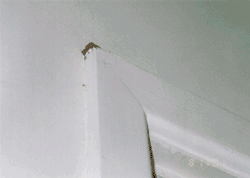 Subterranean
termites are native to virtually every State in Australia. Although small
in size they are large in numbers. Termites congregate in enormous underground
colonies, as deep as 5m underground, that house hundreds of thousands
to millions of individual termites. They are dispersed throughout the
soil at feeding sites around your home.
Subterranean
termites are native to virtually every State in Australia. Although small
in size they are large in numbers. Termites congregate in enormous underground
colonies, as deep as 5m underground, that house hundreds of thousands
to millions of individual termites. They are dispersed throughout the
soil at feeding sites around your home.
How can a professional pest control firm help?
Only a trained professional understands the intricacies of how a termite colony behaves.
Using advanced materials a skilled, professional applicator can effectively apply a termite barrier that is designed to conrol termites and minimise the risk from any future termite attack.
But if I leave the termites in the tree they won't be interested in my house, right?
Unfortunately, there is no guarantee that the termites won't eat your tree, your house and your neighbour's house and whatever else is within a 150-metre radius.
Houses and other buildings provide termites with the ideal combination of warmth, moisture and food sources. Termites can find ways to enter your house that you've never thought of. They are small enough to gain entry into hidden areas of basements, crawl spaces, and concrete slabs, through openings as small as 0.8mm.
Termite survival depends on finding edible material to support the colony. Moving out from their colony, they tunnel through the soil in search of moisture and food. They forage around bark landscaping, near air conditioner drip lines and below gutters. They also like tree stumps, timber decks, buried wood or construction material, and piles of firewood. A loose mortar joint, a small space around a drain pipe, or a settlement crack in the concrete slab is all they need to gain entry to your home.
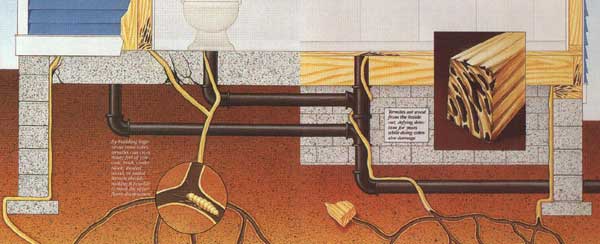
Termites eat wood from the inside out, defying detection for years while doing extensive damage. By building ingenious mud tubes, termites can cross many feet of concrete, brick, cinder block, treated wood or metal termite shields, making it possible to reach the upper floors of a structure.
My house is steel-framed. I am going to be free of termites, right?
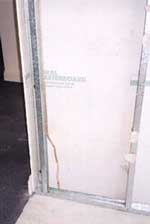 Unfortunately
not. If there is no chemical treatment under your slab, and the concrete
cracks, the termites will enter via the cracks. All they need to gain
access is 1/16th of an inch. Any materials such as gyprock, staircases,
kitchen cupboards, skirting boards, doorframes, etc. are all susceptible.
Unfortunately
not. If there is no chemical treatment under your slab, and the concrete
cracks, the termites will enter via the cracks. All they need to gain
access is 1/16th of an inch. Any materials such as gyprock, staircases,
kitchen cupboards, skirting boards, doorframes, etc. are all susceptible.
I haven't seen swarming termites, or traces of damage, can my home still be in danger?
Unfortunately, yes. When a colony swarms, the winged termites are reproductive males and females and may be in the air for just a few minutes.
Termites colonise structural members internally and eat wood from the inside out; making their activity detectable only by a professional termite inspection.
When is the right time to call in a termite professional?
The longer you delay treatment, the more damage termites will do. The termite treatment and structural repairs will become more extensive and more expensive. Generally speaking, the sooner you approve treatment, the better.
How does a professional inspection uncover termite activity that's invisible to me?
 While
much termite damage is hidden, termites have a few secrets to the eyes
of a professional.
While
much termite damage is hidden, termites have a few secrets to the eyes
of a professional.
Professional pest control managers are well trained in termite behaviour. They have available sophisticated equipment to detect termite activity, and they can also determine how the termites got there.
As professionals they will be familiar with the treatment options and how to use them to CUSTOMISE A TREATMENT PROGRAM THAT IS SPECIFICALLY DESIGNED TO PROTECT YOUR MOST IMPORTANT INVESTMENT .. YOUR HOME.
What will be done to get rid of the termites?
 An
invisible barrier will be created between your home and the termites,
blocking them from your house.
An
invisible barrier will be created between your home and the termites,
blocking them from your house.
1) Treatment begins with a thorough inspection.
2) Then, an analysis of your home and property.
3) And finally, applying an invisible barrier to effectively control,
repel and prevent re-entry of termites for many years.
Please click here to read through our 15 step termite treatment for your home
What about consideration of children and pets?
Animals should be considered during treatment. For example, your pets should be relocated during this period. We recommend waiting until the chemicals have dried, which will depend on the weather.
For your child's safety we prefer that they are not present during the treatment, although this is up to you.
How long does a treatment take?
 Usually
a full day, depending on the size of the building.
Usually
a full day, depending on the size of the building.
Won't this kind of thorough treatment be a lot of trouble?
No. A modern termite control treatment may usually take a day or two, or maybe even less, with very little upset to your daily routine. And, considering the fact that a home is the largest single investment most Austalian families will ever make, protecting its value is not much trouble at all.
Do you cut manholes or trapdoors into my floorboards?
 We
use a fibre optic bora scope (camera) through a 19mm hole, which enables
us to see the complete subfloor and treatment. If we find substantial
termite mud tunnels that cannot be removed with treatment, we may need
to cut a manhole or trapdoor.
We
use a fibre optic bora scope (camera) through a 19mm hole, which enables
us to see the complete subfloor and treatment. If we find substantial
termite mud tunnels that cannot be removed with treatment, we may need
to cut a manhole or trapdoor.
Do you have to drill holes in my tiles?
As a requirement of the Australian Standard, it is necessary to cover all entry points of termites under concrete as well as suspended floors. Normally a 6mm hole is made in the grout cross-section and re-grouted to colour match.
Will the house smell after being treated?
We use Biflex, which is formulated for existing house treatments. It has citronella-based aroma. Odours will also be determined by your subfloor, ventilation, height and soil type, ie; sand soaks up the chemical quickly, whereas clay takes longer to absorb. Floor coverings do not allow vapours to escape as easily as bare floorboards.
Once my house has been treated, won't the termites move to the neighbour's house?
Very often this is true. However, if it is a well-established colony, more than one house is likely to have a termite infestation, and they are probably already attacking a neighbour's house. Once your house has been treated, yes, termites will then search for other food sources.
I had my home pre treated - so I shouldn't have a problem with termites, right?
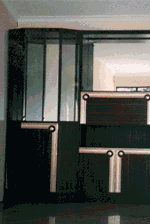 Even
if the pest controller pre treated your house under perfect treatment
and building construction conditions, there are still factors that can
destroy the effectiveness of a pre treatment.
Even
if the pest controller pre treated your house under perfect treatment
and building construction conditions, there are still factors that can
destroy the effectiveness of a pre treatment.
The chemical barrier may be destroyed if:
- Treated soil is disturbed during construction
- Treated soil is mixed with untreated soil during landscaping
- Rain or sprinkler systems cause erosion and soil movement
- Surrounding or under slab foundations are damaged by tree root activity
Cracks in the foundations of a house are an easy entry point for termites. They are not always visible to the homeowner or pest controller, and may be difficult to find and identify. Over time, termiticides can break down and render the barrier ineffective. One or more spot-treatments may be necesary to re-establish a continuous termiticide barrier.
The company came out and spot-treated my house, and now the termites are back!
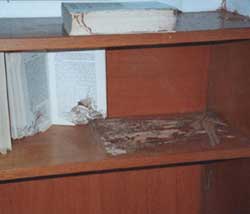 Contact
the company and express your concern to the management. In some cases
a representative of the termiticide manufacturer or industry consultant
may assist in determining the problem.
Contact
the company and express your concern to the management. In some cases
a representative of the termiticide manufacturer or industry consultant
may assist in determining the problem.
Termites may remain trapped for more than six months after a treatment, depending on how much access they have to moisture within your home. If there is very little moisture and a secondary termite nest does not exist in your home, the trapped termites are usually very disorientated, have stopped feeding, and will therefore no longer be an economical threat to your home.
A good spot-treatment should establish an effective termite barrier to possible entry points. HOWEVER, a good spot-treatment is just that! It is not a guarantee against re-infestation.
Termites have damaged my home .. is the pest controller responsible for the repairs?
Check your warranty contract. It will tell you whether or not the company will pay for damage caused by termites. Contractual disputes are often resolved in the small claims court or the law courts.
What are the essential components of a good termite service?
A good termite service should include:
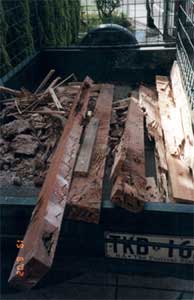 A
thorough inspection of the property and all buildings .. inside and
out including roof and ceiling spaces.
A
thorough inspection of the property and all buildings .. inside and
out including roof and ceiling spaces.- Identification of wood to earth contact, such as fences or pergolas in the ground that touch the home.
- Locating areas of excessive moisture and sloping soil levels .. soil levels that allow water to pool around the foundation walls, leaking water taps, air conditioning units, pool filters and above-ground swimming pools.
- Proper application of the termiticide .. according to label, Australian Standards and Federal and State Laws.
- Complete barrier termiticide application .. for long term residual control. It must be noted however, that even the most thorough and complete barrier application of whatever termite barrier product is used does not guarantee against further termite attack. In some cases termites will still find a way to enter your home where early detection of activity is possible.
 Landscaping
is something that new home owners do as soon as or shortly after they
move into their home.
Landscaping
is something that new home owners do as soon as or shortly after they
move into their home.
This form of "new home enthusiasm" commonly relates to digging up the soil in contact with the house, replacing old plants for new, installing "you beaut" water irrigation system and then covering the newly planted area with timber bark. Sometimes even the whole area is kept in place with a garden edge consisting of old railway sleepers.
PLEASE NOTE: This new "home enthusiasm" is a recipe for disaster, unless you the homeowner seek professional advice before you disturb any amount of soil.
The advice you need to seek, in the first instance is from a reputable and professional termite specialist, because the soil in close proximity to the exterior of your home at ground level is protected from termite attack by a termite control agent. As soon as you disturb the soil around the immediate exterior of your home, you have destroyed the protection the termite control agent provides.
Even if your house is BRAND NEW seek the advice of a reputable and professional termite specialist. A common misconception amongst new homeowners is that termites only attack older homes. THIS IS NOT TRUE!
If you are engaging a professional landscape specialist, MAKE SURE that you introduce that person to the termite specialist before any amount of soil is disturbed.
REMEMBER - Prevention is better than cure!
We use Biflex. We've chosen FMC's Biflex over all the other termiticides because it combines powerful protection and environmental compatibility.
 Click
here for more information about Biflex
Click
here for more information about Biflex
Click here to find out more about Biflex
and Repellency
Click here to read the Biflex Material Safety
Data Sheet